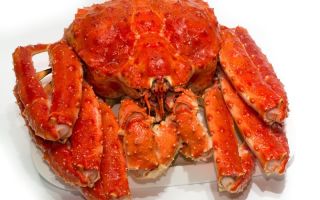Content
Crab meat is a seafood obtained from the belly, claws and legs of a crab. The benefits and harms of crab meat are often underestimated, so it is important to know how to choose and prepare a product so as not to spoil its beneficial properties and not harm yourself.
What is crab meat
The natural product is obtained from the belly, claws and limbs of the crab and is delicious, easily absorbed in the body and has great health benefits.
It is important to distinguish meat from surimi sticks, which consist of finely chopped and compressed fish or even soy. They do not have any special beneficial properties, and additives of unnatural origin can even harm the body.
Crab meat is obtained from marine and freshwater crabs. Sea specimens are tastier, contain more nutrients and are of great benefit to humans.
The chemical composition and calorie content of crab meat
Crab meat is very high in protein and low in fat and carbohydrates, nutritional value per 100 g:
- proteins - 18 g;
- fats - 1.8 g;
- carbohydrates - 0.4 g.
Seafood contains vitamins B1, B9, B6, B2, B5, B3, A and macro- and microelements: potassium, selenium, magnesium, calcium, zinc, phosphorus, sodium, iodine, iron, manganese, copper.
The benefits of crab meat
A large number of useful properties of crab meat is due to its rich chemical composition.
Crab meat is a dietary high-protein product, it is perfect for athletes and will be useful for losing weight.
Vitamin B3, found in meat, stabilizes cholesterol levels and normalizes metabolism. Vitamin B5 has a positive effect on brain activity and helps the body absorb other nutrients. Vitamin B6 contributes to the normal functioning of the nervous system and slows down the aging of the skin. Vitamin A and Taurine support good vision and are powerful antioxidants.
Zinc is beneficial in promoting normal brain function and bone health. Potassium has a positive effect on the functioning of the musculoskeletal system, brain and circulatory system. Iodine is good for the thyroid gland. Other minerals in the composition maintain the water-salt balance in the body and are beneficial for digestion.
Another property of crab meat is its benefits for men: being an aphrodisiac, seafood increases potency and is an excellent prevention of male diseases.
How to butcher and peel a crab
All limbs are removed from a boiled individual. Using special scissors, cut the shell on the abdomen along a natural line, as shown in the picture. The internal organs (intestines and gills) are removed and discarded; the meat should be removed.
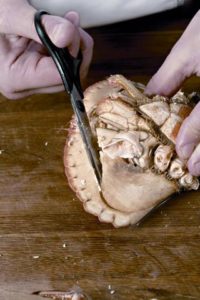
The claws and legs of the animal are split with the handle of a heavy knife, tongs or a rolling pin, and the meat is removed from them.
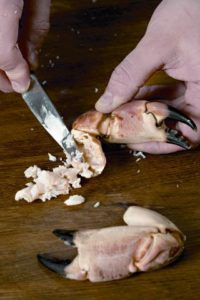
You can get the meat from the legs with a small fork.
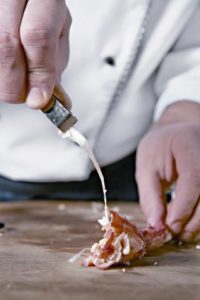
If you need to cut a large species (Kamchatka, for example), you will have to use kitchen scissors or pruning shears. A longitudinal incision is made on each leg, with each phalanx being cut separately.To do this, it is better to divide the phalanges by spinning them in different directions.

After that, the meat is removed from the phalanges of the legs and the chitinous strips are removed with tweezers.
How to cook and boil crab
The carcasses are boiled whole or cut, in the latter case, they quickly reach condition.
The amount of water is calculated as follows: 2.5 l per 500 g of product. After boiling, it is better not to add water and calculate its amount in advance.
For cooking, sea water is ideal. If it is not possible to use such water, fresh water with sea salt instead of regular is a good substitute.
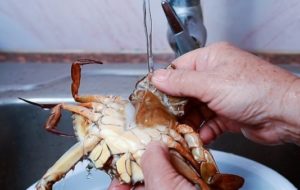
Put salt and spices in the water (this can be lemon juice, pepper, garlic, cloves, bay leaf to taste) after boiling. Then you need to wait for the next boil and only after that throw the carcass itself into the pan.
Boiling lasts 15-40 minutes depending on the size of the crab.
- Crabs weighing up to 1.5 kg are boiled for 20-25 minutes.
- Weight over 1.5 kg is boiled for 30-40 minutes.
Readiness is indicated by the red color of the shell and a strong characteristic aroma.
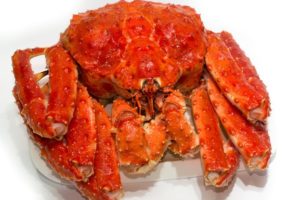
The finished carcasses should be cooled, placing them on the back, this will preserve the juiciness and taste.
The carcass can also be cooked in a double boiler, pressure cooker, multicooker or microwave. There is also a way to steam crab using a saucepan and colander. The advantage of this method is that when using it, seafood quickly reaches a state of readiness and has high taste properties.
Pour water into the pan until it barely touches the colander placed on it. The carcasses are laid out in a colander, spices are added to the water. The colander is placed in a saucepan, the water is brought to a boil. The seafood is cooked until tender.
When cooking in the microwave, the carcass must be wrapped in a wet towel and squeezed several times so that the surface of the crab is well moistened and steam is released during cooking. Before putting food in the microwave, each part should be wrapped in a plastic wrap. This is to prevent an explosion, which often happens to a whole crab carcass when heated without water. The microwave is turned on for 2-3 minutes. If after the end of her work you do not feel a pronounced aroma, you need to repeat the process.
What can be cooked from crab meat.
You can cook a lot of dishes from crab meat: the famous salad, sandwiches with crab paste, rolls, soup, crab phalanges in a wok, tartlets and bruschetta with crab meat.
Harm of crab meat and contraindications
Crab meat has only one contraindication: strong individual intolerance.
How to choose and store crab meat
Crabs can be purchased frozen, live, chilled, or cooked. Of the first three options, the most optimal is to buy a living marine or freshwater inhabitant.
Among live crabs, you should choose young and active ones, while they should not be small. Young animals are easily identified by their dense shell. It is better to give preference to males, they differ from females in a shorter and curved tail under the abdomen.
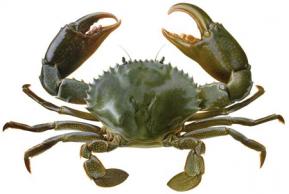
There should be no damage on the body of the individual. They collect harmful bacteria that can be harmful to humans. In addition, the meat of such an animal will be less tasty.
If the specimen is large and active, but the shell is not very strong, it is also suitable for cooking. The animal could have been caught at the moment of the shell change, this will not harm or affect the taste of the finished meat.
Shallow and deep-sea crabs do not differ in price or taste.
In frozen form, crabs are stored for up to a year. Live specimens are kept refrigerated in the vegetable section. It is better not to delay the preparation time and do it no later than a few hours after purchase.
Conclusion
The benefits and harms of crab meat depend on the knowledge and care of the cook. It is important to approach the cooking process carefully and responsibly, and the product will retain its benefits and high taste.

